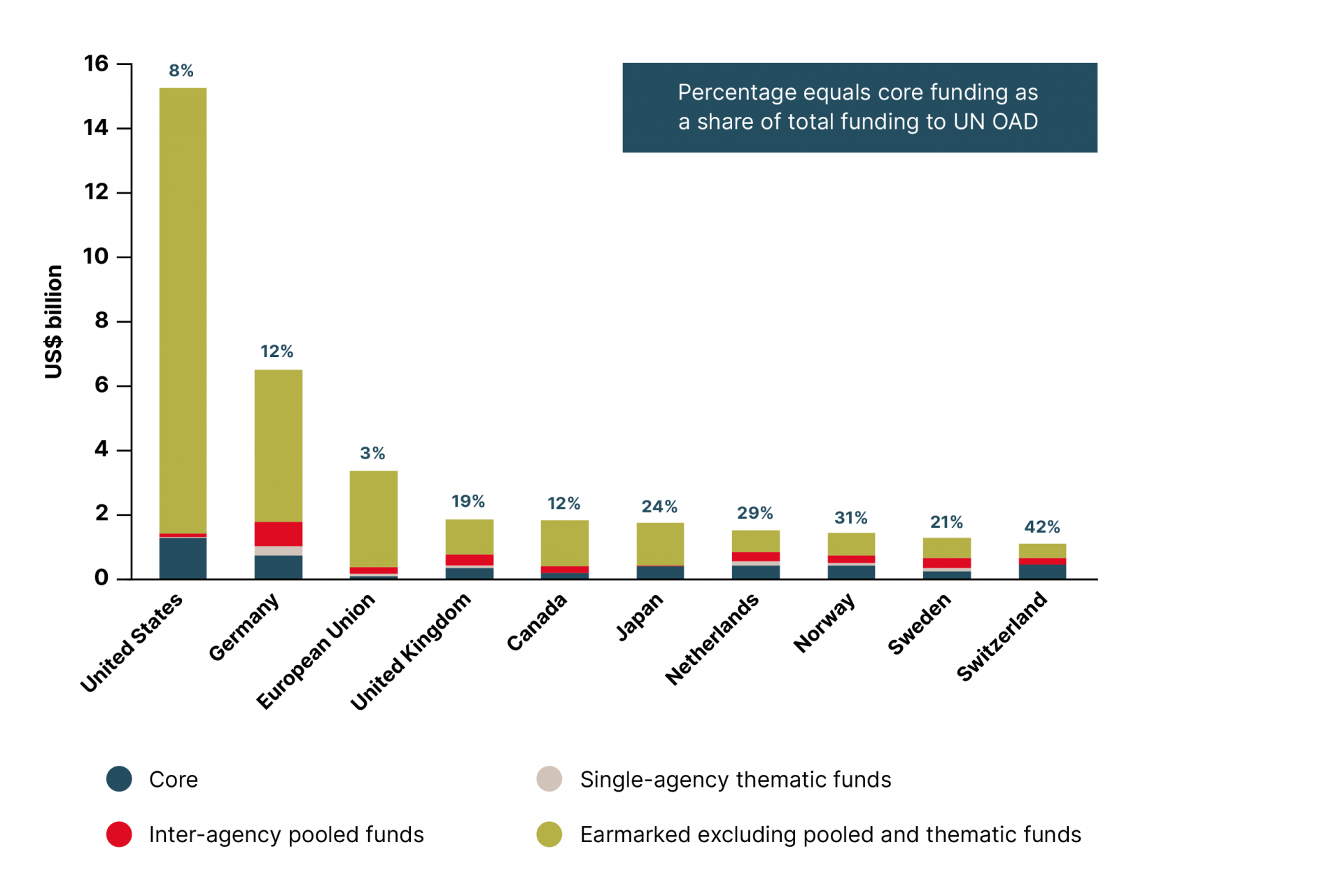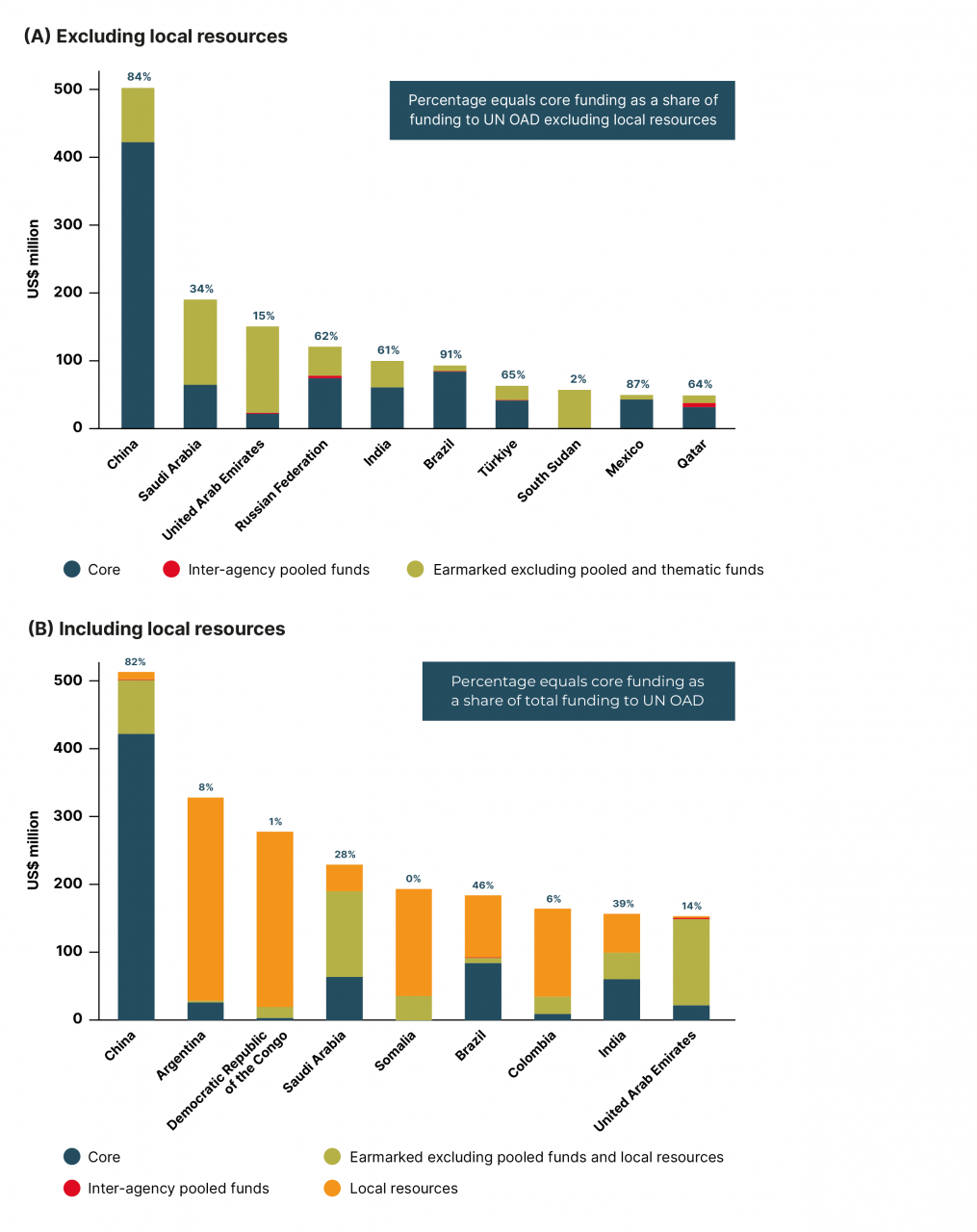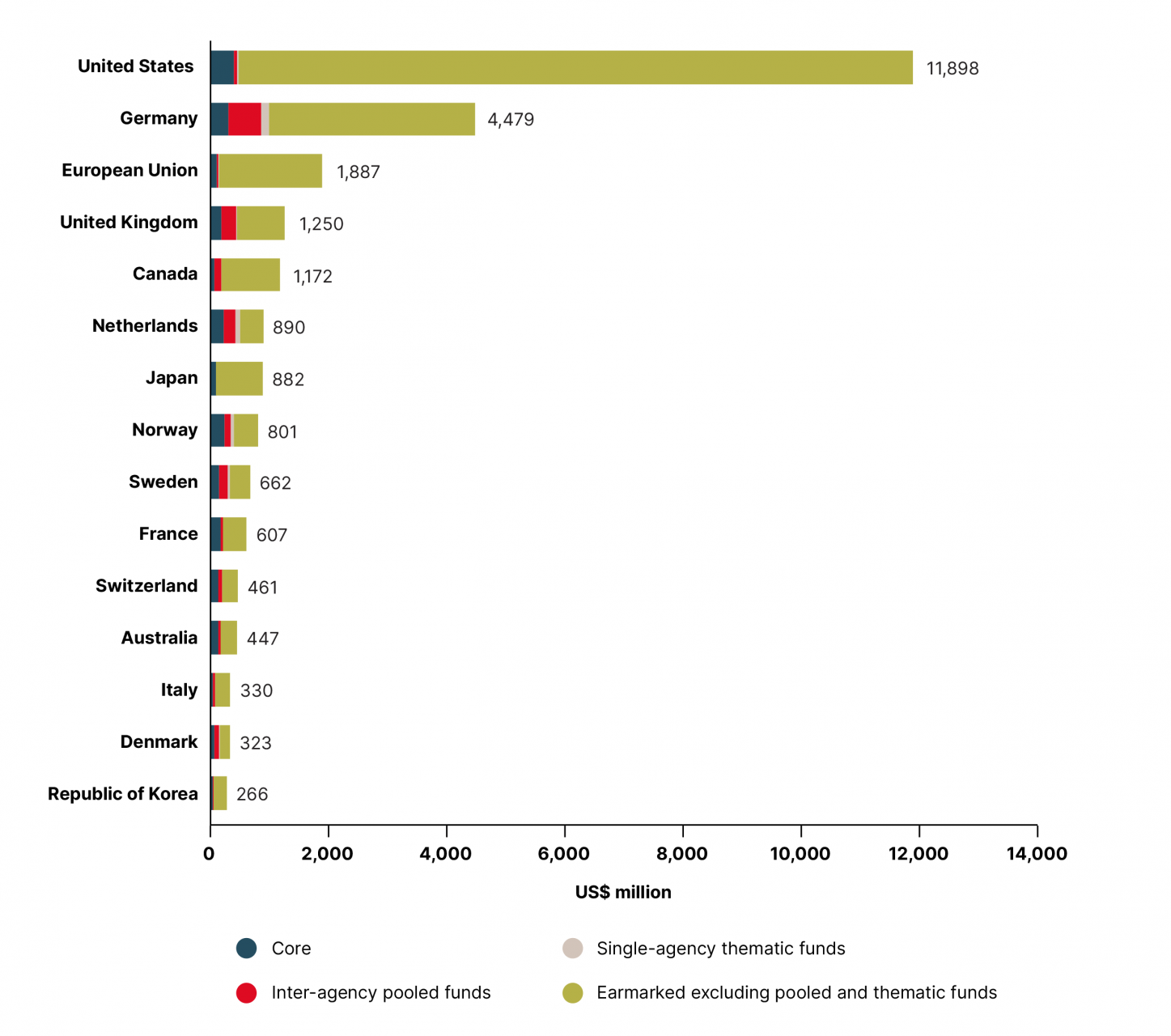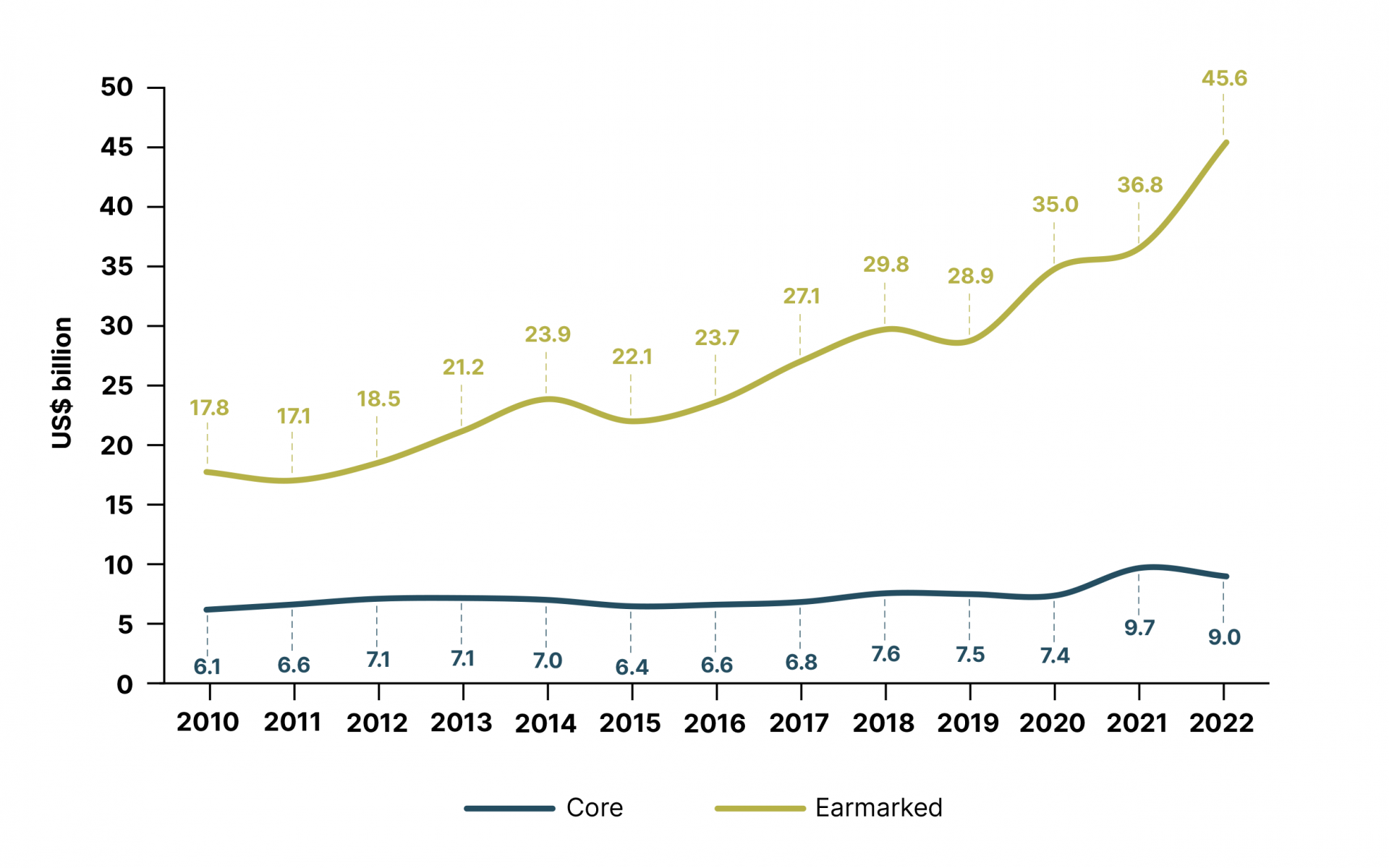Up to this point, the data presented has been for revenue to the UN system as a whole, incorporating all entities that report to the CEB. Figures 13 to 18 focus on the UN development system (UNDS), which encompasses entities promoting sustainable development and welfare in developing countries and countries in transition – referred to as UN operational activities for development (OAD). Despite what the name might suggest, OAD includes both development assistance-related activities and humanitarian assistance. In essence, the entities that constitute the UNDS are those with a mandate to promote economic and social development. In 2022, contributions to UN OAD were 73%, or US$ 54.5 billion, of total UN system revenue (see definitions in Box 2).
The distribution of core and earmarked contributions to UN OAD since 2010 is depicted in Figure 13. Revenue growth over this period is primarily explained by increased earmarked funding, which had an average annual growth rate of 8.1% between 2022 and 2010, compared to a 3.2% annual average increase for core funding over the same period. In 2022, earmarked contributions comprised 84% of UN OAD revenues, compared to 67% for the UN system. This difference can be attributed to the fact that the other two UN functions – peace operations and to a lesser extent global agenda – are largely funded from assessed contributions. Earmarked contributions to OAD in 2022 reached a historic high of US$ 45.6 billion, following a consistent upward trend. Compared to 2021, earmarked funding for OAD grew 24%, while core contributions decreased 8%. This decline is primarily due to reduced voluntary core contributions recorded as 2022 revenue, stemming partly from the upfront revenue recognition of multi-year agreements following IPSAS (see Box 1).
The total 2022 contributions by the top ten OECD-DAC members are illustrated in Figure 14, along with a breakdown of the financing instruments they utilised to support UN OAD. It is noteworthy that, unlike in Figure 9, the EU’s status as an OECD-DAC member means it is included within the top contributors. As previously remarked, the EU rarely provides assessed or voluntary core contributions to the UN. Of the US$ 3.3 billion the EU contributed to UN OAD in 2022, just 3% was core funding. The majority of this was provided to address climate and biodiversity crises, with US$ 1.4 million going to UNEP and US$ 0.9 million to the United Nations Framework Convention on Climate Change (UNFCCC).
Eight of the top ten UN OAD contributors are also among the top ten contributors to the UN system, with funding concentrated among a consistent group of donors. Figures 14 and 15 present the funding mix to the UNDS of, respectively, the top ten OECD-DAC and top ten non- OECD-DAC contributors. Inter-agency pooled funds and single-agency thematic funds are singled out due to their ‘core-like’ features of more flexible earmarked funding.
The percentages in Figure 14 indicate the proportion of core funding within each OECD-DAC contributor’s total funding to UN OAD. While five out of the top ten provide 20% or more of their contribution through core funding, the three largest contributors – the United States, Germany, and the EU – predominately funnel resources through earmarked funding.
Funding composition for UN OAD: Top 10 OECD-DAC contributors, 2022 (US$ billion)

Key insights in a flash
Report of the Secretary-General (A/79/72 - E/2024/12) and UN Pooled Funds Database.
The top ten OECD-DAC contributors together provided 65% of overall UN OAD funding in 2022, with the choice of financing instrument varying between contributors. Switzerland and Norway contributed more than 30% of their funding as core resources.19 Netherlands, Sweden, the United Kingdom and Germany also provided a substantial share of their contributions as core, or ‘core-like’ resources, while the United States and Japan contributed mainly through more tightly earmarked funding. Again, the EU is a unique case, rarely providing core funding due to the nature of the organisation.
Figure 15 illustrates the top ten non-OECD-DAC members’ total OAD contributions in 2022. On the top figure, the ranking excludes local resources – which are provided by countries for the purposes of implementing their own national development plans – while on the bottom figure, they are included. In both cases, China is the largest contributor to UN OAD, providing more than US$ 500 million. When considering local resources, Argentina, the Democratic Republic of Congo, Somalia, and Colombia enter the top ten UN OAD funding partners within the non-OECD-DAC group.
The non-OECD-DAC contributors to UN OAD display a more diverse funding mix. Contributions to inter-agency pooled funds, although more limited in this group, are to a degree growing. Qatar, the Russian Federation, Türkiye, and Brazil funded the UN Central Emergency Response Fund (CERF), as well as country funds in their respective regions. Single-agency thematic funds have not been singled out as such contributions are not significant within the group. Most countries contribute a higher proportion of core funding than the top OECD-DAC countries.
Funding composition for UN OAD: Top 10 non-OECD-DAC contributors, including and excluding local resources 2022 (US$ million)

Key insights in a flash
Report of the Secretary-General (A/79/72 - E/2024/12) and UN Pooled Funds Database.
Figures 16 and 17 illustrate the funding mix of the top 15 contributors to, respectively, development assistance and humanitarian assistance – the two functions that constitute UN OAD. Although the funding mix differs between development and humanitarian assistance, the pattern of funding being concentrated in a limited number of contributors remains the same.
The top five development assistance donors – the United States, Germany, the EU, Japan, and Canada – accounted for 39% of total contributions to development assistance. On the humanitarian side, the concentration of funding resources in a few contributors is even higher, with the top five donors – the United States, Germany, the EU, the United Kingdom, and Canada – accounting for 60% of total contributions to humanitarian assistance.
Funding composition for UNDS development assistance: Top 15 contributors, 2022 (US$ million)

Key insights in a flash
Report of the Secretary-General (A/79/72 - E/2024/12) and UN Pooled Funds Database.
Funding composition for UNDS humanitarian assistance: Top 15 contributors, 2022 (US$ million)

Key insights in a flash
Report of the Secretary-General (A/79/72 - E/2024/12) and UN Pooled Funds Database.
Total funding for development assistance increased to US$ 20 billion in 2022, compared to around US$ 19 billion the previous year. Of these resources, US$ 5.6 billion for core resources (28%), US$ 8.9 billion (45%) for resources earmarked to a specific project or programme, and US$ 1.3 billion (6%) channelled through inter-agency pooled funds.
Looking at the funding mix, there is considerable diversity between contributors. In general, development assistance is funded with core resources to a higher degree than humanitarian assistance. As Figure 16 demonstrates, nine of the top 15 contributors in 2022 provided more than 30% of their development assistance funding in core resources.
Funding for humanitarian assistance grew to US$ 34.6 billion in 2022, compared to US$ 27 billion in 2021. The United States was the top contributor, providing 58% of the humanitarian funding to UN OAD in 2022, equivalent to US$ 12 billion. This represented an increase of US$ 5.6 billion compared to the previous year’s US$ 7 billion. WFP received US$ 7 billion – US$ 3.4 billion more than in 2021 – and UNHCR US$ 2.2 billion.
Core funding accounted for 10% of humanitarian assistance funding in 2022. Among the earmarked resources, 71% (US$ 24.6 billion) was earmarked for a specific programme or project, while 9% came via more flexible earmarking, including both single-agency thematic funds and inter-agency pooled funds.
